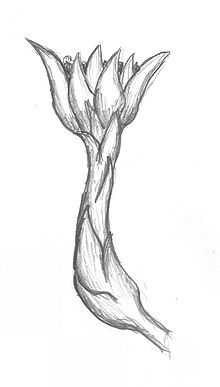Rhizanthella
| Underground Orchid | |
|---|---|
 | |
| Rhizanthella gardneri | |
| Scientific classification | |
| Kingdom: | Plantae |
| (unranked): | Angiosperms |
| (unranked): | Monocots |
| Order: | Asparagales |
| Family: | Orchidaceae |
| Subfamily: | Epidendroideae |
| Tribe: | Gastrodieae |
| Subtribe: | Rhizanthellinae |
| Genus: | Rhizanthella R. S. Rogers |
| Type species | |
| Rhizanthella gardneri R. S. Rogers (1928) | |
| Species | |
| |
| Synonyms[1] | |
|
Cryptanthemis Rupp | |
Rhizanthella, commonly known as underground orchids, is a small epiparasitic, achlorophyllous, subterranean genus of orchid. It has three known species, all endemic to Australia.[1][2] It is abbreviated in trade journals as Rhi.
These orchids are rare and their status is considered vulnerable to critical, mostly due to loss of habitat. They live underground in symbiosis with mycorrhizal fungi. These subterranean rhizomes or tubers are short and thickened, without roots, serving as storage for the orchid. The leaves are absent.
When the orchid prepares to flower, the solitary inflorescences break through the surface, beneath the leaf litter. The terminal inflorescence is racemose. It gives rise to a cluster of small, tubular, hermaphroditic flowers. The fragrant flowerheads are about 5 cm wide and contain numerous, inward-facing, small flowers.
Pollination is carried out by small flies or other insects, even underground by termites or gnats. The fruit is a fleshy, indehiscent drupe; each plant gives up to 250 minute seeds.
Their discovery in 1928 caused such an excitement among orchid lovers, that a wax model had to be toured around Britain.
References
- ↑ 1.0 1.1 Kew World Checklist of Selected Plant Families
- ↑ Pridgeon, A.M., Cribb, P.J., Chase, M.C. & Rasmussen, F.N. (2001). Orchidoideae (Part 1). Genera Orchidacearum 2: 1-416. Oxford University Press, New York, Oxford.
- George, A. S. (1981). Rhizanthella-The Underground Orchid of Western Australia. Proceedings of the Orchid Symposium, 13th International Botanical Congress 77-78.
- Dixon, K. W., et al. (1990). The Western Australian fully subterranean orchid Rhizanthella gardneri. Orchid Biology, Reviews and Perspectives. V. J. Arditti. Portland, Oregon, Timber Press. 5: 37-62.
- Dixon, K. (2003) Underground Orchids on the Edge. Plant Talk, 31: 34-35.
- Jones, D.L. & Clements, M.A. (2006). Rhizanthella omissa, a new species of underground orchid from south eastern Australia. The Orchadian, vol. 15, no. 3, pp. 131–133.
Further reading
- Hoffman, N., Brown, A. (1998). Orchids of South-west Australia. University of Western Australia Press, Nedlands.Rev. 2nd ed. with suppl. ISBN 1-876268-18-2
- Jones, David L. (2006). A complete guide to native orchids of Australia: including the island territories. Frenchs Forest. ISBN 1-877069-12-4.
- Underground orchid - Rhizanthella gardneri at ARKive.org (includes photographs)
| Wikimedia Commons has media related to Rhizanthella. |
| Wikispecies has information related to: Rhizanthella |